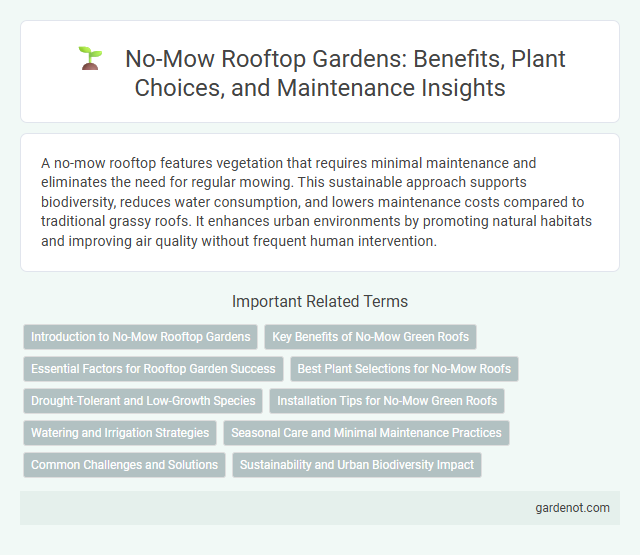A no-mow rooftop features vegetation that requires minimal maintenance and eliminates the need for regular mowing. This sustainable approach supports biodiversity, reduces water consumption, and lowers maintenance costs compared to traditional grassy roofs. It enhances urban environments by promoting natural habitats and improving air quality without frequent human intervention.
Introduction to No-Mow Rooftop Gardens
No-mow rooftop gardens are innovative green roof solutions designed to reduce maintenance by eliminating the need for regular mowing. These gardens typically feature low-growing, drought-resistant plants like sedums, mosses, and native grasses that thrive with minimal care. Implementing no-mow rooftop gardens enhances urban biodiversity, improves stormwater management, and increases roof insulation while significantly lowering labor and equipment costs.
Key Benefits of No-Mow Green Roofs
No-mow green roofs significantly reduce maintenance costs by eliminating the need for mowing and regular upkeep, promoting energy efficiency through enhanced insulation and temperature regulation. These rooftop ecosystems improve urban biodiversity by providing habitats for pollinators and birds while mitigating stormwater runoff, thus decreasing the burden on city drainage systems. Their low-maintenance nature supports sustainability goals and extends the lifespan of roofing materials, making them an eco-friendly investment for green infrastructure.
Essential Factors for Rooftop Garden Success
Selecting drought-resistant native plants is essential for a no-mow rooftop garden, as these species require minimal watering and maintenance. Ensuring a lightweight, well-draining growing medium supports healthy root development and prevents waterlogging, which enhances plant survival and longevity. Proper irrigation design and sunlight exposure tailored to rooftop conditions further optimize plant growth and reduce maintenance needs.
Best Plant Selections for No-Mow Roofs
Best plant selections for no-mow green roofs include drought-tolerant sedums, native grasses, and low-growing wildflowers that require minimal maintenance and thrive in shallow soil. Succulent varieties like Sedum album and Sedum spurium provide excellent ground cover with strong resistance to heat and drought. Incorporating native prairie species such as blue grama grass and creeping thyme enhances biodiversity while reducing irrigation needs on no-mow rooftops.
Drought-Tolerant and Low-Growth Species
No-mow rooftop green roofs utilize drought-tolerant and low-growth species such as Sedum, Sempervivum, and drought-resistant grasses that require minimal irrigation and maintenance. These plants thrive in shallow substrate layers, conserving water while reducing mowing needs, making them ideal for sustainable urban environments. Implementing no-mow rooftops enhances energy efficiency and supports biodiversity with minimal ecological footprint.
Installation Tips for No-Mow Green Roofs
Select drought-tolerant, low-maintenance native plant species suited for no-mow green roofs to minimize watering and upkeep demands. Ensure a properly engineered waterproof membrane and robust root barrier are installed to protect the building structure while supporting plant growth. Utilize lightweight, nutrient-rich growing mediums with efficient drainage systems to optimize plant health and reduce soil erosion on no-mow rooftops.
Watering and Irrigation Strategies
No-mow rooftops rely on drought-tolerant plant species that significantly reduce irrigation needs, optimizing water conservation and minimizing maintenance. Efficient watering strategies include drip irrigation systems and rainwater harvesting, which enhance moisture retention without oversaturation. Smart irrigation controllers adapt watering schedules based on weather data, ensuring precise water use and preventing runoff in green roof environments.
Seasonal Care and Minimal Maintenance Practices
No-mow rooftop green spaces thrive with minimal maintenance by relying on drought-tolerant native plants that require seasonal pruning and occasional irrigation. Seasonal care involves removing dead foliage in late fall and monitoring for invasive weeds in spring to preserve plant health without extensive mowing. Efficient nutrient management through slow-release fertilizers supports sustained growth and reduces the need for frequent interventions on no-mow rooftops.
Common Challenges and Solutions
No-mow rooftops often face challenges such as insufficient soil depth, water retention issues, and invasive weed growth that compromise plant health and rooftop stability. Implementing engineered soil blends with high organic content improves moisture retention, while selecting drought-resistant native species minimizes irrigation needs and maintenance. Regular monitoring and targeted weed removal ensure a sustainable, low-maintenance green roof ecosystem that supports biodiversity and reduces urban heat island effects.
Sustainability and Urban Biodiversity Impact
No-mow rooftops enhance urban sustainability by reducing water consumption and eliminating the need for chemical fertilizers and pesticides, thus lowering environmental pollution. These low-maintenance green roofs support urban biodiversity by providing habitats for pollinators, birds, and beneficial insects, contributing to ecosystem resilience. Implementing no-mow rooftop systems helps cities mitigate heat island effects while promoting carbon sequestration and improving air quality.
No-mow rooftop Infographic

 gardenot.com
gardenot.com